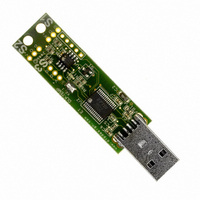DLP-TEMP-G DLP Design Inc, DLP-TEMP-G Datasheet - Page 2

DLP-TEMP-G
Manufacturer Part Number
DLP-TEMP-G
Description
MODULE DATA-ACQUISITION 3-CH
Manufacturer
DLP Design Inc
Series
DLP-TEMPr
Datasheet
1.DLP-TEMP-G.pdf
(5 pages)
Specifications of DLP-TEMP-G
Accessory Type
Module Data Acquisition
Interface Type
USB
Product
Interface Modules
For Use With/related Products
USB
Lead Free Status / RoHS Status
Lead free / RoHS Compliant
Lead Free Status / RoHS Status
Lead free / RoHS Compliant, Lead free / RoHS Compliant
Other names
813-1015
Available stocks
Company
Part Number
Manufacturer
Quantity
Price
Company:
Part Number:
DLP-TEMP-G
Manufacturer:
DLP Design
Quantity:
135
The microcontroller used is the PIC12F683, 8-pin, Flash-based microcontroller from Microchip.
As mentioned above, the 12F683 is preprogrammed for analog voltage measurement and for
reading the digital temperature sensors, but it can also be erased and reprogrammed with user
code if desired. Reprogramming the micro requires a user-supplied device programmer. (Refer
to the schematic at the end of this document for the pin out of the programming header.)
The microcontroller uses a single port pin and a pull-up resistor to communicate with each digital
temperature sensor. Refer to the DS18B20’s datasheet for a complete description of its
communications protocol. The firmware for the DLP-TEMP-G was written in C and can be
downloaded from dlpdesign.com.
USB INTERFACE
The USB interface was implemented using the FT232RL USB-UART IC from FTDI. This device
connects to the host computer via the Type A USB (male) connector and supports the 8 standard
RS232 serial signals. Only the TX and RX signals are used on the DLP-TEMP-G board and are
all that is required to form a serial connection to the host computer. Since handshaking is not
used in this design, the firmware in the 12F683 processor must be ready to accept all incoming
serial data from the host computer or the data will be lost.
In order for the DLP-TEMP-G (and FT232RL) to receive incoming serial data from the host,
FTDI’s VCP (Virtual Com Port) drivers must be installed. The driver installation process is
initiated by simply plugging the DLP-TEMP-G into a USB port. The driver installation wizard will
prompt for the location of the drivers files (in a folder or on a floppy) and will copy the required
files to the proper destination such that the next time the board is connected the driver files will be
automatically loaded without prompting the user. The VCP driver files can be downloaded for
free from dlpdesign.com or ftdichip.com.
Once the drivers are loaded and the com port number for the DLP-TEMP-G is set in Device
Manager, the application program running on the host simply opens what it thinks is an RS232
port (9600, N, 8, 1) and begins communicating with the 12F683 microcontroller.
COMMUNICATIONS PROTOCOL
For this design, a rather simplistic protocol was selected in an attempt to present the design in as
basic a way as possible. Single-byte commands are used to communicate with the 12F683
microcontroller. The following table shows the command list:
COMMAND
R (read and convert)
P (ping)
S
12F683 Response
Send back 18 bytes of data from the sensors and start another
temperature conversion in both sensors. Provided as legacy
support for compatibility with the original DLP-TEMP.
Echo the letter ‘Q’ back to the host. Provided as legacy support
for compatibility with the original DLP-TEMP.
Read temperature sensor at S1, return data and convert
2




















